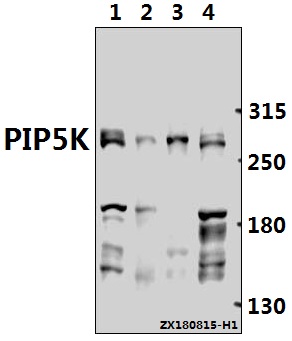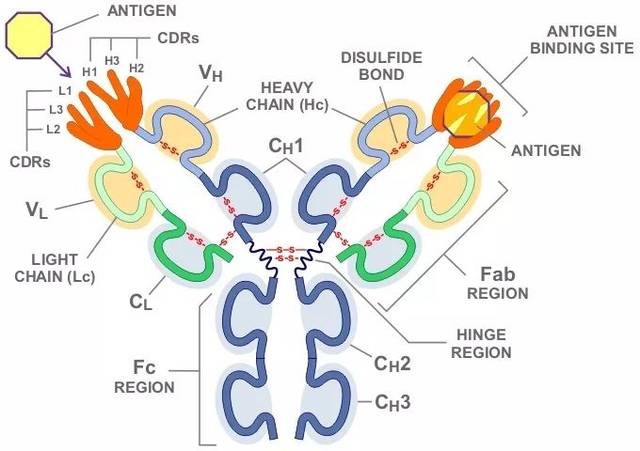Product Name :
PIP5K (Q95) polyclonal antibody Background :
Phosphatidylinositol-4-phosphate-5-kinase (PIPK) synthesizes phosphatidylinositol-4,5-bisphosphate, which regulates various processes including cell proliferation, survival, membrane trafficking and cytoskeletal organization. The PIPK family is divided into type I, type II and type III. Each type of the PIPK family phosphorylates distinct substrates. They contain an activation loop, which determines their enzymatic specificity and subcellular targeting. The phosphatidylinositol-4-phosphate-5-kinase type I consists of three members, PIPK I α, β and γ, which are characterized by phosphorylating PI4P on the 5-hydroxyl. PIPK I α, designated PIPK I β in mouse, is expressed in brain tissue. PIPK I β, designated PIPK I α in mouse, is also called STM7. PIPK I γ has two variants produced by alternative splicing which are expressed in lung, brain and kidneys. Product :
Rabbit IgG, 1mg/ml in PBS with 0.02% sodium azide, 50% glycerol, pH7.2 Storage&Stability :
Store at 4°C short term. Aliquot and store at -20°C long term. Avoid freeze-thaw cycles. Specificity :
PIP5K (Q95) pAb detects endogenous levels of PIP5K protein. Immunogen :
Synthetic peptide, corresponding to amino acids 65-125 of Human PIP5K. Conjugate :
Unconjugated Modification :
Unmodification
PIP5K (Q95) polyclonal antibody Background :
Phosphatidylinositol-4-phosphate-5-kinase (PIPK) synthesizes phosphatidylinositol-4,5-bisphosphate, which regulates various processes including cell proliferation, survival, membrane trafficking and cytoskeletal organization. The PIPK family is divided into type I, type II and type III. Each type of the PIPK family phosphorylates distinct substrates. They contain an activation loop, which determines their enzymatic specificity and subcellular targeting. The phosphatidylinositol-4-phosphate-5-kinase type I consists of three members, PIPK I α, β and γ, which are characterized by phosphorylating PI4P on the 5-hydroxyl. PIPK I α, designated PIPK I β in mouse, is expressed in brain tissue. PIPK I β, designated PIPK I α in mouse, is also called STM7. PIPK I γ has two variants produced by alternative splicing which are expressed in lung, brain and kidneys. Product :
Rabbit IgG, 1mg/ml in PBS with 0.02% sodium azide, 50% glycerol, pH7.2 Storage&Stability :
Store at 4°C short term. Aliquot and store at -20°C long term. Avoid freeze-thaw cycles. Specificity :
PIP5K (Q95) pAb detects endogenous levels of PIP5K protein. Immunogen :
Synthetic peptide, corresponding to amino acids 65-125 of Human PIP5K. Conjugate :
Unconjugated Modification :
Unmodification
-
 Western blot (WB) analysis of PIP5K (Q95) pAb at 1:1000 dilution Lane1:A2780 whole cell lysate(40ug) Lane2:The Testis tissue lysate of Rat(40ug) Lane3:The Testis tissue lysate of Mouse(30ug) Lane4:Hela whole cell lysate(40ug)
Western blot (WB) analysis of PIP5K (Q95) pAb at 1:1000 dilution Lane1:A2780 whole cell lysate(40ug) Lane2:The Testis tissue lysate of Rat(40ug) Lane3:The Testis tissue lysate of Mouse(30ug) Lane4:Hela whole cell lysate(40ug)
Bioworld Biotech only provide peptides for our antibodies and do not provide additional peptide customization services.
Price/Size :
USD 368/1mg/vial
Tips:
For phospho antibody, we provide phospho peptide(0.5mg) and non-phospho peptide(0.5mg).Describe :
Blocking peptides are peptides that bind specifically to the target antibody and block antibody binding. These peptide usually contains the epitope recognized by the antibody. Antibodies bound to the blocking peptide no longer bind to the epitope on the target protein. This mechanism is useful when non-specific binding is an issue, for example, in Western blotting (WB) and Immunohistochemistry (IHC). By comparing the staining from the blocked antibody versus the antibody alone, one can see which staining is specific; Specific binding will be absent from the western blot or IHC performed with the neutralized antibody.Formula:
Synthetic peptide was lyophilized with 100% acetonitrile and is supplied as a powder. Reconstitute with 0.1 ml DI water for a final concentration of 10 mg/ml.The purity is >90%,tested by HPLC and MS.
Storage:
The freeze-dried powder is more stable. For short time at 2-8°C. For long term storage store at -20°C.
Note :
This product is for research use only (RUO only). Not for use in diagnostic or therapeutic procedures.
 PIP5K (Q95) polyclonal antibody
PIP5K (Q95) polyclonal antibody  Datasheet
Datasheet COA
COA MSDS
MSDS SHIP
SHIP